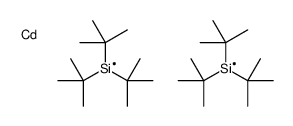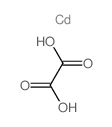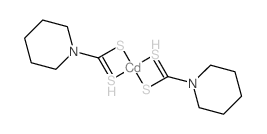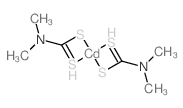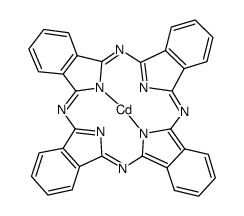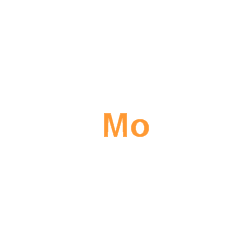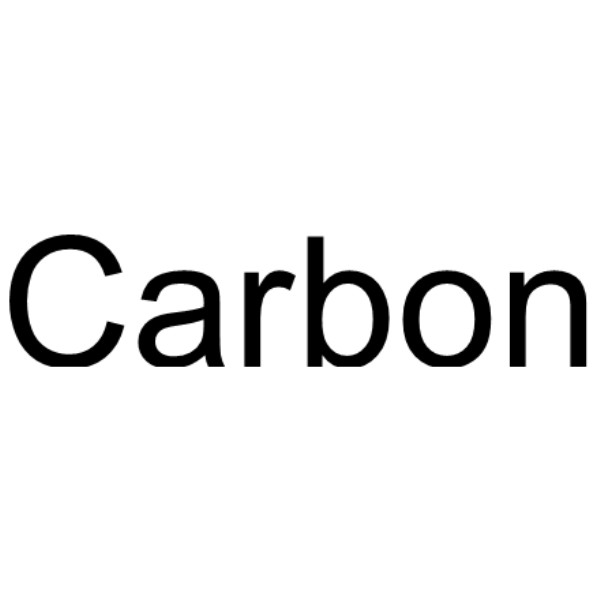毒理学数据:
IARC评价为可疑致癌物。吸入镉燃烧形成的氧化镉烟雾,可引起急性肺水肿和化学性肺炎。个别病例可伴有肝、肾损害。对眼有刺激性。
生态学数据:
水中浓度 0.1mg/L时,使 BOD5 降低。镉从不同来源到储留地及最终进入有机体的主要输送,可经大气、水悬浮的沉积物、土地施用及废物堆置。暂时性固定于水生系统的底质和悬浮物质中的痕量金属镉,主要对水生生物产生毒效应。镉浓度大于 2mg/L时,水出现诨浊,浓度25mg/L时,水有涩味。
CHEMICAL IDENTIFICATION
-
RTECS NUMBER :
-
EU9800000
-
CHEMICAL NAME :
-
Cadmium
-
CAS REGISTRY NUMBER :
-
7440-43-9
-
LAST UPDATED :
-
199712
-
DATA ITEMS CITED :
-
110
-
MOLECULAR FORMULA :
-
Cd
-
MOLECULAR WEIGHT :
-
112.40
-
WISWESSER LINE NOTATION :
-
.CD
HEALTH HAZARD DATA
ACUTE TOXICITY DATA
-
TYPE OF TEST :
-
TCLo - Lowest published toxic concentration
-
ROUTE OF EXPOSURE :
-
Inhalation
-
SPECIES OBSERVED :
-
Human - man
-
DOSE/DURATION :
-
88 ug/m3/8.6Y
-
TOXIC EFFECTS :
-
Kidney, Ureter, Bladder - proteinuria
-
TYPE OF TEST :
-
LCLo - Lowest published lethal concentration
-
ROUTE OF EXPOSURE :
-
Inhalation
-
SPECIES OBSERVED :
-
Human
-
DOSE/DURATION :
-
39 mg/m3/20M
-
TOXIC EFFECTS :
-
Cardiac - other changes Vascular - thrombosis distant from injection site Lungs, Thorax, or Respiration - respiratory depression
-
TYPE OF TEST :
-
LDLo - Lowest published lethal dose
-
ROUTE OF EXPOSURE :
-
Unreported
-
SPECIES OBSERVED :
-
Human - man
-
DOSE/DURATION :
-
15 mg/kg
-
TOXIC EFFECTS :
-
Details of toxic effects not reported other than lethal dose value
-
TYPE OF TEST :
-
LD50 - Lethal dose, 50 percent kill
-
ROUTE OF EXPOSURE :
-
Oral
-
SPECIES OBSERVED :
-
Rodent - rat
-
DOSE/DURATION :
-
2330 mg/kg
-
TOXIC EFFECTS :
-
Details of toxic effects not reported other than lethal dose value
-
TYPE OF TEST :
-
LC50 - Lethal concentration, 50 percent kill
-
ROUTE OF EXPOSURE :
-
Inhalation
-
SPECIES OBSERVED :
-
Rodent - rat
-
DOSE/DURATION :
-
25 mg/m3/30M
-
TOXIC EFFECTS :
-
Lungs, Thorax, or Respiration - dyspnea
-
TYPE OF TEST :
-
LD50 - Lethal dose, 50 percent kill
-
ROUTE OF EXPOSURE :
-
Unreported
-
SPECIES OBSERVED :
-
Rodent - rat
-
DOSE/DURATION :
-
1140 mg/kg
-
TOXIC EFFECTS :
-
Details of toxic effects not reported other than lethal dose value
-
TYPE OF TEST :
-
LD50 - Lethal dose, 50 percent kill
-
ROUTE OF EXPOSURE :
-
Oral
-
SPECIES OBSERVED :
-
Rodent - mouse
-
DOSE/DURATION :
-
890 mg/kg
-
TOXIC EFFECTS :
-
Details of toxic effects not reported other than lethal dose value
-
TYPE OF TEST :
-
LD50 - Lethal dose, 50 percent kill
-
ROUTE OF EXPOSURE :
-
Intraperitoneal
-
SPECIES OBSERVED :
-
Rodent - mouse
-
DOSE/DURATION :
-
5700 ug/kg
-
TOXIC EFFECTS :
-
Details of toxic effects not reported other than lethal dose value
-
TYPE OF TEST :
-
LD50 - Lethal dose, 50 percent kill
-
ROUTE OF EXPOSURE :
-
Unreported
-
SPECIES OBSERVED :
-
Rodent - mouse
-
DOSE/DURATION :
-
890 mg/kg
-
TOXIC EFFECTS :
-
Details of toxic effects not reported other than lethal dose value
-
TYPE OF TEST :
-
LDLo - Lowest published lethal dose
-
ROUTE OF EXPOSURE :
-
Oral
-
SPECIES OBSERVED :
-
Rodent - rabbit
-
DOSE/DURATION :
-
70 mg/kg
-
TOXIC EFFECTS :
-
Details of toxic effects not reported other than lethal dose value
-
TYPE OF TEST :
-
LDLo - Lowest published lethal dose
-
ROUTE OF EXPOSURE :
-
Subcutaneous
-
SPECIES OBSERVED :
-
Rodent - rabbit
-
DOSE/DURATION :
-
6 mg/kg
-
TOXIC EFFECTS :
-
Details of toxic effects not reported other than lethal dose value
-
TYPE OF TEST :
-
LDLo - Lowest published lethal dose
-
ROUTE OF EXPOSURE :
-
Intravenous
-
SPECIES OBSERVED :
-
Rodent - rabbit
-
DOSE/DURATION :
-
5 mg/kg
-
TOXIC EFFECTS :
-
Details of toxic effects not reported other than lethal dose value
-
TYPE OF TEST :
-
TDLo - Lowest published toxic dose
-
ROUTE OF EXPOSURE :
-
Oral
-
SPECIES OBSERVED :
-
Rodent - rat
-
DOSE/DURATION :
-
546 mg/kg/26W-C
-
TOXIC EFFECTS :
-
Blood - changes in serum composition (e.g. TP, bilirubin, cholesterol) Nutritional and Gross Metabolic - weight loss or decreased weight gain Biochemical - Enzyme inhibition, induction, or change in blood or tissue levels - transaminases
-
TYPE OF TEST :
-
TDLo - Lowest published toxic dose
-
ROUTE OF EXPOSURE :
-
Oral
-
SPECIES OBSERVED :
-
Rodent - rat
-
DOSE/DURATION :
-
1512 mg/kg/48W-C
-
TOXIC EFFECTS :
-
Liver - other changes Kidney, Ureter, Bladder - other changes Nutritional and Gross Metabolic - changes in metals, not otherwise specified
-
TYPE OF TEST :
-
TDLo - Lowest published toxic dose
-
ROUTE OF EXPOSURE :
-
Oral
-
SPECIES OBSERVED :
-
Mammal - pig
-
DOSE/DURATION :
-
21880 mg/kg/78W-C
-
TOXIC EFFECTS :
-
Vascular - BP elevation not characterized in autonomic section
-
TYPE OF TEST :
-
TCLo - Lowest published toxic concentration
-
ROUTE OF EXPOSURE :
-
Inhalation
-
SPECIES OBSERVED :
-
Human - woman
-
DOSE/DURATION :
-
129 ug/m3/20Y-C
-
TOXIC EFFECTS :
-
Tumorigenic - Carcinogenic by RTECS criteria Lungs, Thorax, or Respiration - tumors
-
TYPE OF TEST :
-
TDLo - Lowest published toxic dose
-
ROUTE OF EXPOSURE :
-
Subcutaneous
-
SPECIES OBSERVED :
-
Rodent - rat
-
DOSE/DURATION :
-
3372 ug/kg
-
TOXIC EFFECTS :
-
Tumorigenic - Carcinogenic by RTECS criteria Tumorigenic - tumors at site of application
-
TYPE OF TEST :
-
TDLo - Lowest published toxic dose
-
ROUTE OF EXPOSURE :
-
Intramuscular
-
SPECIES OBSERVED :
-
Rodent - rat
-
DOSE/DURATION :
-
40 mg/kg/4W-I
-
TOXIC EFFECTS :
-
Tumorigenic - Carcinogenic by RTECS criteria Musculoskeletal - tumors Tumorigenic - tumors at site of application
-
TYPE OF TEST :
-
TDLo - Lowest published toxic dose
-
ROUTE OF EXPOSURE :
-
Unreported
-
SPECIES OBSERVED :
-
Rodent - rat
-
DOSE/DURATION :
-
1200 mg/kg
-
TOXIC EFFECTS :
-
Tumorigenic - equivocal tumorigenic agent by RTECS criteria Reproductive - Tumorigenic effects - testicular tumors Tumorigenic - tumors at site of application
-
TYPE OF TEST :
-
TD - Toxic dose (other than lowest)
-
ROUTE OF EXPOSURE :
-
Intramuscular
-
SPECIES OBSERVED :
-
Rodent - rat
-
DOSE/DURATION :
-
70 mg/kg
-
TOXIC EFFECTS :
-
Tumorigenic - equivocal tumorigenic agent by RTECS criteria Blood - lymphoma, including Hodgkin's disease Tumorigenic - tumors at site of application
-
TYPE OF TEST :
-
TD - Toxic dose (other than lowest)
-
ROUTE OF EXPOSURE :
-
Intramuscular
-
SPECIES OBSERVED :
-
Rodent - rat
-
DOSE/DURATION :
-
63 mg/kg
-
TOXIC EFFECTS :
-
Tumorigenic - equivocal tumorigenic agent by RTECS criteria Blood - lymphoma, including Hodgkin's disease Tumorigenic - tumors at site of application
-
TYPE OF TEST :
-
TD - Toxic dose (other than lowest)
-
ROUTE OF EXPOSURE :
-
Intramuscular
-
SPECIES OBSERVED :
-
Rodent - rat
-
DOSE/DURATION :
-
45 mg/kg/4W-I
-
TOXIC EFFECTS :
-
Tumorigenic - neoplastic by RTECS criteria Musculoskeletal - tumors Tumorigenic - tumors at site of application
-
TYPE OF TEST :
-
TDLo - Lowest published toxic dose
-
ROUTE OF EXPOSURE :
-
Oral
-
DOSE :
-
155 mg/kg
-
SEX/DURATION :
-
male 13 week(s) pre-mating female 13 week(s) pre-mating - 3 week(s) after conception
-
TOXIC EFFECTS :
-
Reproductive - Effects on Newborn - growth statistics (e.g.%, reduced weight gain) Reproductive - Effects on Newborn - behavioral
-
TYPE OF TEST :
-
TDLo - Lowest published toxic dose
-
ROUTE OF EXPOSURE :
-
Oral
-
DOSE :
-
220 mg/kg
-
SEX/DURATION :
-
female 1-22 day(s) after conception
-
TOXIC EFFECTS :
-
Reproductive - Effects on Embryo or Fetus - other effects to embryo
-
TYPE OF TEST :
-
TDLo - Lowest published toxic dose
-
ROUTE OF EXPOSURE :
-
Oral
-
DOSE :
-
21500 ug/kg
-
SEX/DURATION :
-
multigenerations
-
TOXIC EFFECTS :
-
Reproductive - Fertility - pre-implantation mortality (e.g. reduction in number of implants per female; total number of implants per corpora lutea) Reproductive - Effects on Newborn - germ cell effects (in offspring)
-
TYPE OF TEST :
-
TDLo - Lowest published toxic dose
-
ROUTE OF EXPOSURE :
-
Oral
-
DOSE :
-
23 mg/kg
-
SEX/DURATION :
-
female 1-22 day(s) after conception
-
TOXIC EFFECTS :
-
Reproductive - Specific Developmental Abnormalities - blood and lymphatic systems (including spleen and marrow)
-
TYPE OF TEST :
-
TDLo - Lowest published toxic dose
-
ROUTE OF EXPOSURE :
-
Intraperitoneal
-
DOSE :
-
1124 ug/kg
-
SEX/DURATION :
-
male 1 day(s) pre-mating
-
TOXIC EFFECTS :
-
Reproductive - Paternal Effects - spermatogenesis (incl. genetic material, sperm morphology, motility, and count)
-
TYPE OF TEST :
-
TDLo - Lowest published toxic dose
-
ROUTE OF EXPOSURE :
-
Subcutaneous
-
DOSE :
-
250 ug/kg
-
SEX/DURATION :
-
female 19 day(s) after conception
-
TOXIC EFFECTS :
-
Reproductive - Effects on Newborn - biochemical and metabolic
-
TYPE OF TEST :
-
TDLo - Lowest published toxic dose
-
ROUTE OF EXPOSURE :
-
Intravenous
-
DOSE :
-
1250 ug/kg
-
SEX/DURATION :
-
female 14 day(s) after conception
-
TOXIC EFFECTS :
-
Reproductive - Specific Developmental Abnormalities - body wall Reproductive - Specific Developmental Abnormalities - urogenital system
-
TYPE OF TEST :
-
TDLo - Lowest published toxic dose
-
ROUTE OF EXPOSURE :
-
Intravenous
-
DOSE :
-
1250 ug/kg
-
SEX/DURATION :
-
female 9 day(s) after conception
-
TOXIC EFFECTS :
-
Reproductive - Specific Developmental Abnormalities - Central Nervous System Reproductive - Specific Developmental Abnormalities - eye/ear
-
TYPE OF TEST :
-
TDLo - Lowest published toxic dose
-
ROUTE OF EXPOSURE :
-
Intravenous
-
DOSE :
-
8 mg/kg
-
SEX/DURATION :
-
female 8-15 day(s) after conception
-
TOXIC EFFECTS :
-
Reproductive - Effects on Embryo or Fetus - fetotoxicity (except death, e.g., stunted fetus)
-
TYPE OF TEST :
-
TDLo - Lowest published toxic dose
-
ROUTE OF EXPOSURE :
-
Oral
-
DOSE :
-
448 mg/kg
-
SEX/DURATION :
-
multigenerations
-
TOXIC EFFECTS :
-
Reproductive - Effects on Embryo or Fetus - fetotoxicity (except death, e.g., stunted fetus) Reproductive - Effects on Embryo or Fetus - fetal death
-
TYPE OF TEST :
-
TDLo - Lowest published toxic dose
-
ROUTE OF EXPOSURE :
-
Oral
-
DOSE :
-
1700 mg/kg
-
SEX/DURATION :
-
female 8-12 day(s) after conception
-
TOXIC EFFECTS :
-
Reproductive - Effects on Newborn - viability index (e.g., # alive at day 4 per # born alive) Reproductive - Effects on Newborn - growth statistics (e.g.%, reduced weight gain)
-
TYPE OF TEST :
-
TDLo - Lowest published toxic dose
-
ROUTE OF EXPOSURE :
-
Intraperitoneal
-
DOSE :
-
1686 ug/kg
-
SEX/DURATION :
-
female 7 day(s) after conception
-
TOXIC EFFECTS :
-
Reproductive - Specific Developmental Abnormalities - Central Nervous System
-
TYPE OF TEST :
-
TDLo - Lowest published toxic dose
-
ROUTE OF EXPOSURE :
-
Parenteral
-
DOSE :
-
2 mg/kg
-
SEX/DURATION :
-
female 8 day(s) after conception
-
TOXIC EFFECTS :
-
Reproductive - Specific Developmental Abnormalities - craniofacial (including nose and tongue)
MUTATION DATA
-
TYPE OF TEST :
-
Cytogenetic analysis
-
TEST SYSTEM :
-
Rodent - hamster Ovary
-
REFERENCE :
-
CGCGBR Cytogenetics and Cell Genetics. (S. Karger Pub., Inc., 79 Fifth Ave., New York, NY 10003) V.12- 1973- Volume(issue)/page/year: 26,251,1980 *** REVIEWS *** ACGIH TLV-Suspected human carcinogen DTLVS* The Threshold Limit Values (TLVs) and Biological Exposure Indices (BEIs) booklet issues by American Conference of Governmental Industrial Hygienists (ACGIH), Cincinnati, OH, 1996 Volume(issue)/page/year: TLV/BEI,1997 ACGIH TLV-TWA 0.01 mg(Cd)/m3 DTLVS* The Threshold Limit Values (TLVs) and Biological Exposure Indices (BEIs) booklet issues by American Conference of Governmental Industrial Hygienists (ACGIH), Cincinnati, OH, 1996 Volume(issue)/page/year: TLV/BEI,1997 IARC Cancer Review:Animal Sufficient Evidence IMEMDT IARC Monographs on the Evaluation of Carcinogenic Risk of Chemicals to Man. (WHO Publications Centre USA, 49 Sheridan Ave., Albany, NY 12210) V.1- 1972- Volume(issue)/page/year: 2,74,1973 IARC Cancer Review:Animal Sufficient Evidence IMEMDT IARC Monographs on the Evaluation of Carcinogenic Risk of Chemicals to Man. (WHO Publications Centre USA, 49 Sheridan Ave., Albany, NY 12210) V.1- 1972- Volume(issue)/page/year: 11,39,1976 IARC Cancer Review:Human Sufficient Evidence IMEMDT IARC Monographs on the Evaluation of Carcinogenic Risk of Chemicals to Man. (WHO Publications Centre USA, 49 Sheridan Ave., Albany, NY 12210) V.1- 1972- Volume(issue)/page/year: 58,119,1993 IARC Cancer Review:Human Limited Evidence IMSUDL IARC Monographs, Supplement. (WHO Publications Centre USA, 49 Sheridan Ave., Albany, NY 12210) No.1- 1979- Volume(issue)/page/year: 7,139,1987 IARC Cancer Review:Animal Limited Evidence IMEMDT IARC Monographs on the Evaluation of Carcinogenic Risk of Chemicals to Man. (WHO Publications Centre USA, 49 Sheridan Ave., Albany, NY 12210) V.1- 1972- Volume(issue)/page/year: 58,119,1993 IARC Cancer Review:Group 1 IMEMDT IARC Monographs on the Evaluation of Carcinogenic Risk of Chemicals to Man. (WHO Publications Centre USA, 49 Sheridan Ave., Albany, NY 12210) V.1- 1972- Volume(issue)/page/year: 58,119,1993 TOXICOLOGY REVIEW TRBMAV Texas Reports on Biology and Medicine. (Galveston, TX) V.1-41(2), 1943-81/82. Discontinued. Volume(issue)/page/year: 33,85,1975 TOXICOLOGY REVIEW JDSCAE Journal of Dairy Science. (American Dairy Science Assoc., 309 W. Clark St., Champaign, IL 61820) V.1- 1917- Volume(issue)/page/year: 58,1767,1975 TOXICOLOGY REVIEW JFDSAZ Journal of Food Science. (Institute of Food Technologists, Suite 2120, 221 N. La Salle St., Chicago, IL 60601) V.26- 1961- Volume(issue)/page/year: 39,321,1974 TOXICOLOGY REVIEW AMBOCX Ambio. A Journal of the Human Environment. (Pergamon Press Inc., Maxwell House, Fairview Park, Elmsford, NY 10523) V.1- 1972- Volume(issue)/page/year: 3,55,1974 TOXICOLOGY REVIEW QURBAW Quarterly Reviews of Biophysics. (Cambridge Univ. Press, The Edinburgh Bldg., Shaftesbury Rd., Cambridge CB2 2RU, UK) V.1- 1968- Volume(issue)/page/year: 7,75,1974 TOXICOLOGY REVIEW AEMBAP Advances in Experimental Medicine and Biology. (Plenum Pub. Corp., 233 Spring St., New York, NY 10013) V.1- 1967- Volume(issue)/page/year: 40,239,1973 TOXICOLOGY REVIEW NTIS** National Technical Information Service. (Springfield, VA 22161) Formerly U.S. Clearinghouse for Scientific & Technical Information. Volume(issue)/page/year: PB221-198 TOXICOLOGY REVIEW KOTTAM Kogai to Taisaku. Journal of Environmental Pollution Control. (Kogai Taisaku Gijutsu Dokokai, Shuwa-Akasaka Bldg., 9-1-244, Akasaka, Minato-ku, Tokyo 107, Japan) V.1- 1965- Volume(issue)/page/year: 11,1300,1975 TOXICOLOGY REVIEW FOREAE Food Research. (Champaign, IL) V.1-25, 1936-60. For publisher information, see JFDSAZ. Volume(issue)/page/year: 7,313,1942 TOXICOLOGY REVIEW STEVA8 Science of the Total Environment. (Elsevier Science Pub. B.V., POB 211, 1000 AE Amsterdam, Netherlands) V.1- 1972- Volume(issue)/page/year: 2,341,1974 TOXICOLOGY REVIEW FCTXAV Food and Cosmetics Toxicology. (London, UK) V.1-19, 1963-81. For publisher information, see FCTOD7. Volume(issue)/page/year: 9,105,1971 TOXICOLOGY REVIEW AJMEAZ American Journal of Medicine. (Technical Pub., 875 Third Ave., New York, NY 10022) V.1- 1946- Volume(issue)/page/year: 38,409,1965 TOXICOLOGY REVIEW ENVRAL Environmental Research. (Academic Press, Inc., 1 E. First St., Duluth, MN 55802) V.1- 1967- Volume(issue)/page/year: 4,71,1971 TOXICOLOGY REVIEW 85CVA2 "Oncology 1970, Proceedings of the Tenth International Cancer Congress," Chicago, Year Book Medical Pub., 1971 Volume(issue)/page/year: 5,63,1970 TOXICOLOGY REVIEW PEXTAR Progress in Experimental Tumor Research. (S. Karger AG, Postfach CH-4009 Basel, Switzerland) V.1- 1960- Volume(issue)/page/year: 12,102,1969 TOXICOLOGY REVIEW PDTNBH Paediatrician. (S. Karger AG, Postfach CH-4009 Basel, Switzerland) V.1- 1972- Volume(issue)/page/year: 6,204,1977 TOXICOLOGY REVIEW BNYMAM Bulletin of the New York Academy of Medicine. (New York Academy of Medicine, 2 E. 103rd St., New York, NY 10029) Ser 2: V.1- 1925- Volume(issue)/page/year: 54,413,1978 TOXICOLOGY REVIEW AMTODM Advances in Modern Toxicology. (John Wiley & Sons, Inc., 605 Third Ave., New York, NY 10016) V.1, 1976-79. Discontinued. Volume(issue)/page/year: 3,209,1977 TOXICOLOGY REVIEW GSAMAQ Memoir--Geological Society of America. (POB 9140, Boulder, CO 80302) No.1- 1934- Volume(issue)/page/year: 123,109,1971 TOXICOLOGY REVIEW 49DXAV "Health Evaluation of Heavy Metals in Infant Formula and Junior Food, Proceedings of the Symposium, 1981," Schmidt, E.H.F., and A.G. Hildebrandt, eds., Berlin, Springer-Verlag, 1983 Volume(issue)/page/year: -,57,1983 TOXICOLOGY REVIEW 43QNAO "Cadmium in the Environment," Nriagu, J.O., ed., 2 vols., New York, John Wiley & Sons, Inc., 1980-81 Volume(issue)/page/year: 2,743,1981 *** U.S. STANDARDS AND REGULATIONS *** MSHA STANDARD-air:TWA 0.2 mg/m3 DTLVS* The Threshold Limit Values (TLVs) and Biological Exposure Indices (BEIs) booklet issues by American Conference of Governmental Industrial Hygienists (ACGIH), Cincinnati, OH, 1996 Volume(issue)/page/year: 3,35,1971 OSHA PEL (Gen Indu):see CFR 29,1910.1027 CFRGBR Code of Federal Regulations. (U.S. Government Printing Office, Supt. of Documents, Washington, DC 20402) Volume(issue)/page/year: 29,1910.1000,1994 OSHA PEL (Construc):see CFR 29,1926.1127 CFRGBR Code of Federal Regulations. (U.S. Government Printing Office, Supt. of Documents, Washington, DC 20402) Volume(issue)/page/year: 29,1926.55,1994 OSHA PEL (Shipyard):see CFR 29,1915.1027 CFRGBR Code of Federal Regulations. (U.S. Government Printing Office, Supt. of Documents, Washington, DC 20402) Volume(issue)/page/year: 29,1915.1000,1993 OSHA PEL (Fed Cont):8H TWA 0.2 mg(Cd)/m3 CFRGBR Code of Federal Regulations. (U.S. Government Printing Office, Supt. of Documents, Washington, DC 20402) Volume(issue)/page/year: 41,50-204.50,1994 *** OCCUPATIONAL EXPOSURE LIMITS *** OEL-ARAB Republic of Egypt:TWA 0.05 mg/m3 JAN 1993 OEL-AUSTRALIA:TWA 0.05 mg/m3 JAN 1993 OEL-BELGIUM:TWA 0.05 mg/m3 JAN 1993 OEL-DENMARK:TWA 0.01 mg/m3 JAN 1993 OEL-FINLAND:TWA 0.02 mg/m3;Carcinogen JAN 1993 OEL-GERMANY;Carcinogen JAN 1993 OEL-INDIA:TWA 0.05 mg/m3 JAN 1993 OEL-JAPAN:TWA 0.05 mg/m3 JAN 1993 OEL-THE NETHERLANDS:TWA 0.02 mg/m3;STEL 0.1 mg/m3 JAN 1993 OEL-THE PHILIPPINES:TWA 0.2 mg/m3 JAN 1993 OEL-RUSSIA:TWA 0.01 mg/m3;STEL 0.05 mg/m3 JAN 1993 OEL-SWEDEN:TWA 0.02 mg/m3;Carcinogen JAN 1993 OEL-SWITZERLAND:TWA 0.05 mg/m3 JAN 1993 OEL-THAILAND:TWA 0.2 mg/m3;STEL 0.5 mg/m3 JAN 1993 OEL-TURKEY:TWA 0.2 mg/m3 JAN 1993 OEL-UNITED KINGDOM:TWA 0.01 mg/m3 JAN 1993 OEL IN BULGARIA, COLOMBIA, JORDAN, KOREA check ACGIH TLV OEL IN NEW ZEALAND, SINGAPORE, VIETNAM check ACGIH TLV *** NIOSH STANDARDS DEVELOPMENT AND SURVEILLANCE DATA *** NIOSH RECOMMENDED EXPOSURE LEVEL (REL) : NIOSH REL TO CADMIUM, dust and fume-air:CA lowest feasible conc. REFERENCE : NIOSH* National Institute for Occupational Safety and Health, U.S. Dept. of Health, Education, and Welfare, Reports and Memoranda. Volume(issue)/page/year: DHHS #92-100,1992 NIOSH OCCUPATIONAL EXPOSURE SURVEY DATA : NOHS - National Occupational Hazard Survey (1974) NOHS Hazard Code - T0608 No. of Facilities: 48 (estimated) No. of Industries: 1 No. of Occupations: 1 No. of Employees: 96 (estimated) NOHS - National Occupational Hazard Survey (1974) NOHS Hazard Code - 15570 No. of Facilities: 1256 (estimated) No. of Industries: 41 No. of Occupations: 50 No. of Employees: 14717 (estimated) NOES - National Occupational Exposure Survey (1983) NOES Hazard Code - T0608 No. of Facilities: 25 (estimated) No. of Industries: 2 No. of Occupations: 3 No. of Employees: 335 (estimated) No. of Female Employees: 22 (estimated) NOES - National Occupational Exposure Survey (1983) NOES Hazard Code - X2776 No. of Facilities: 248 (estimated) No. of Industries: 5 No. of Occupations: 6 No. of Employees: 3893 (estimated) No. of Female Employees: 1887 (estimated) NOES - National Occupational Exposure Survey (1983) NOES Hazard Code - X5979 No. of Facilities: 95 (estimated) No. of Industries: 2 No. of Occupations: 2 No. of Employees: 486 (estimated) NOES - National Occupational Exposure Survey (1983) NOES Hazard Code - 15570 No. of Facilities: 4811 (estimated) No. of Industries: 77 No. of Occupations: 64 No. of Employees: 88968 (estimated) No. of Female Employees: 14541 (estimated)
|








